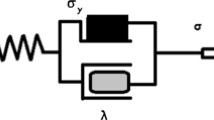Abstract—
The previously proposed piecewise-linear form of the constitutive relations for the relation between stresses and strains has been applied to the description of the processes of cyclic high-temperature deformation of metals and alloys in the regions of linear and nonlinear viscoelasticity. The behavior of two alloys is investigated: the high-temperature and heat-resistant KhN55MVTs alloy at a temperature of 900°С and D16T duralumin at a temperature of 150°С. Methods for determining the material functions included in these ratios and the linearity limit based on the results of experimental studies are presented. The mechanical characteristics of the alloys under study are obtained and their application is demonstrated in the description of various deformation processes, including cyclic deformation in the linear and nonlinear regions under loading according to piecewise-step and sinusoidal laws.
Similar content being viewed by others
REFERENCES
L. M. Kachanov, Creep Theory (Fizmatgiz, Moscow, 1960) [in Russian].
Yu. N. Rabotnov, Creep of Structural Elements (Nauka, Moscow, 1966) [in Russian].
A. P. Rzhanitzin, Theory of Creep (Sroyizdat, Moscow, 1968) [in Russian].
A. A. Il’yushin and B. E. Pobedrya, Fundamentals of the Mathematical Theory of Thermoviscoelasticity (Nauka, Moscow, 1970) [in Russian].
N. N. Malinin, Applied Theory of Plasticity and Creep (Mashinostroenie, Moscow, 1975) [in Russian].
Yu. N. Rabotnov, Elements of Hereditary Mechanics of Solids (Nauka, Moscow, 1977) [in Russian].
G. Z. Sharafutdinov, “Using piece-analytical and piece-linear forms of hereditary-type constitutive equations in studying creep of metals,” Mech. Solids 54, 873–882 (2019). https://doi.org/10.3103/S0025654419060037
Y. A. Dushin, N. N. Gribov, V. A. Ignatov, and N. A. Medvedev, “Structure-stable alloy for structural components of the high-temperature gas-cooled reactor with coolant temperature of 950°C,” Energy 16 (1–2), 317–326 (1991). https://doi.org/10.1016/0360-5442(91)90110-8
V. S. Namestnikov, “Direct and reverse torsion under creep conditions,” Zh. Prikl. Mekh. Tekh. Fiz., No. 1, 120–122 (1960).
Funding
The study was carried out with partial funding of the RFBR project No. 17-08-00210.
Author information
Authors and Affiliations
Corresponding author
Additional information
Translated by A. A. Borimova
About this article
Cite this article
Sharafutdinov, G.Z. USING THE HEREDITARY FORM OF CONSTITUTIVE RELATIONS FOR VISCOSITY IN THE DESCRIPTION OF THE PROCESSES OF CYCLIC HIGH-TEMPERATURE DEFORMATION OF METALS. Mech. Solids 56, 139–149 (2021). https://doi.org/10.3103/S0025654421020126
Received:
Revised:
Accepted:
Published:
Issue Date:
DOI: https://doi.org/10.3103/S0025654421020126




